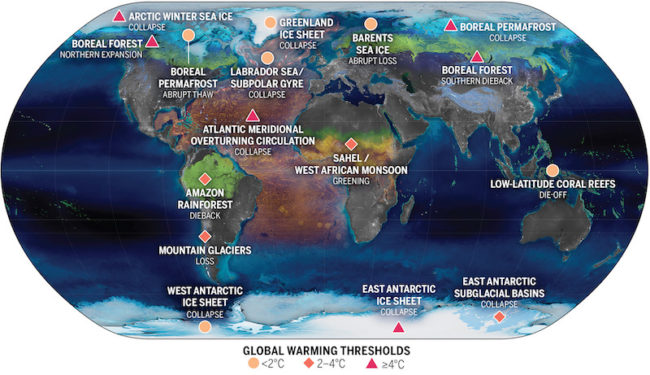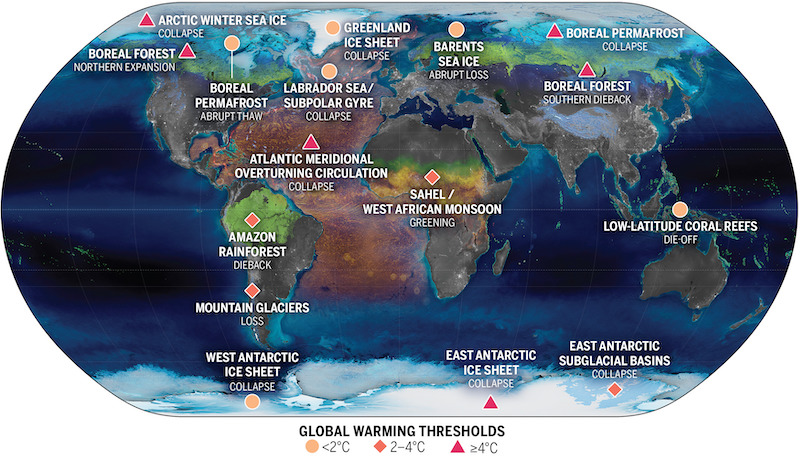
Pins are colored according to our central global warming threshold estimate being below 2°C, i.e., within the Paris Agreement range (light orange, circles); between 2 and 4°C, i.e., accessible with current policies (orange, diamonds); and 4°C and above (red, triangles).
There is a rather alarming new paper that has been published within the peer reviewed journal Science on Sep 9, 2022. Since it is titled “Exceeding 1.5°C global warming could trigger multiple climate tipping points”, I guess you can perhaps say that there is a clue there within the name regarding the content.
This is not your normal paper, but instead is a vitally important alert – we are rapidly heading towards a world of pain … literally.
Who Published This?
There are ten European authors. Together they represent multiple centres of climate subject matter expertise. To be specific, mainly these three institutions …
- Stockholm Resilience Centre, Stockholm University, Stockholm, Sweden.
- Global Systems Institute, University of Exeter, Exeter, UK.
- Potsdam Institute for Climate Impact Research, Potsdam, Germany.
What did they do?
The authors carried out a comprehensive assessment of all suggested climate tipping points, including projected timescales and the impact that would result. This involved doing a deep dive into over 200 previous studies that have been published since 2008 on past tipping points, climate observations and modelling studies.
Additionally they also scoured paleoclimate data, current observations, and the outputs from climate models.
Why did they do this?
This paper is input for a major conference “Tipping Points: from climate crisis to positive transformation” that is being held at the University of Exeter (September 12-14).
The point being highlighted is this …
We have left it too late to tackle climate change incrementally.
It now requires transformational change, and a dramatic acceleration of progress.
That’s not simply an opinion, but rather is a rather robust evidence-based conclusion.
What exactly is a Climate Change Tipping Point?
The term “Tipping point” refers to a critical threshold that, when crossed, results in very large impactful irreversible changes to the global climate system.
Let’s work an example.
There exists what is known as the Gulf Stream. (This is also known as the Atlantic Meridional Overturning Circulation – AMOC). It sends warm surface water from the tropics north, and carries cold fresh water back south. This is a huge influence on the European climate. This ocean current has a tipping point. If freshwater input from melting glaciers reaches a certain threshold, then this current could collapse into a state of reduced flow.
Why?
It is driven by differences in the density of water; colder and more salty water is heavier than warmer fresh water. Pump lots of freshwater off melting glaciers from Greenland and the mechanism that drives it all will be disrupted. Even after the melting stopped, models suggest that it would not return to its current state for thousands of years.
This might also trigger other tipping points.
If it happened, it would also greatly alter the European climate.
Rinse and repeat for other major tipping points such as ice sheet disintegration, permafrost thaw, and rainforest dieback.
If curious to read more about Climate tipping points, then you will find that there is a Wikipedia page that covers the topic rather well.
What does the paper reveal, what are the conclusions they came to?
Our fossil fuel emissions have already pushed Earth into the tipping points danger zone. The paper concludes that multiple climate tipping points could be triggered if global temperature rises beyond 1.5°C above pre-industrial levels.
We literally stand on the brink of catastrophic change. Once triggered, it can’t be rolled back.
In fact it gets even worse.
Even global warming of 1.1°C puts us at risk by triggering some tipping points. To be clear, that is a threshold that we already have passed.
Recent scientific work has suggested that up to 15 tipping elements are now currently active.
They identify nine global “core” tipping elements which contribute substantially to Earth system functioning and seven regional “impact” tipping elements which contribute substantially to human welfare or have great value as unique features of the Earth system
What are the nine global tipping points?
The nine global tipping points identified are:
- the collapse of the Greenland ice sheet
- the collapse of the west Antarctic ice sheet
- the collapse of the first east Antarctic ice sheet
- the collapse of the other east Antarctic ice sheet
- the partial collapse of AMOC (Gulf Stream)
- the total collapse of AMOC (Gulf Stream)
- Amazon dieback
- Permafrost collapse
- Winter sea ice loss in the Arctic.
They also identified seven tipping points would have severe regional effects. These include the die-off of tropical coral reefs and changes to the monsoon patterns.
Author Comments and Immediate risks
I’ve quote mined the following from the associated press release (that can be found here) …
“We can see signs of destabilisation already in parts of the West Antarctic and Greenland ice sheets, in permafrost regions, the Amazon rainforest, and potentially the Atlantic overturning circulation as well.”
– Lead author David Armstrong McKay from Stockholm Resilience Centre, University of Exeter, and the Earth Commission
“The world is already at risk of some tipping points. As global temperatures rise further, more tipping points become possible.”
“The world is heading towards 2-3°C of global warming. This sets Earth on course to cross multiple dangerous tipping points that will be disastrous for people across the world. To maintain liveable conditions on Earth, protect people from rising extremes, and enable stable societies, we must do everything possible to prevent crossing tipping points. Every tenth of a degree counts.”
– Co-author Johan Rockström, co-chair of the Earth Commission and director of the Potsdam Institute for Climate Impact Research
“Since I first assessed climate tipping points in 2008 the list has grown and our assessment of the risk they pose has increased dramatically.”
“Our new work provides compelling evidence that the world must radically accelerate decarbonising the economy to limit the risk of crossing climate tipping points.”
– Co-author Tim Lenton, director of the Global Systems Institute at the University of Exeter and a member of the Earth Commission
“To achieve that we now need to trigger positive social tipping points that accelerate the transformation to a clean energy future.”
“We may also have to adapt to cope with climate tipping points that we fail to avoid, and support those who could suffer uninsurable losses and damages”
“Importantly, many tipping elements in the Earth system are interlinked, making cascading tipping points a serious additional concern. In fact, interactions can lower the critical temperature thresholds beyond which individual tipping elements begin destabilising in the long-run.”
Co-author Ricarda Winkelmann, a researcher at the Potsdam Institute for Climate Impact Research and a member of the Earth Commission
Does this mean we are F**ked?
Short answer: No.
Slightly Longer answer: We still have choices. The chance of crossing tipping points can be reduced by rapidly cutting greenhouse gas emissions, starting immediately.
What this paper does is to provide strong scientific support for the goals of the Paris Agreement – limit global warming to 1.5°C. Go up to and beyond that level of warming and the risk of tipping points escalates.
Global greenhouse gas emissions must be cut by half by 2030, and then reach net-zero by 2050.
Not doing that will have dire consequences.
Further Reading
- Science journal (Sep 9) – Exceeding 1.5°C global warming could trigger multiple climate tipping points
- Associated Press Release by Stockholm University – Risk of multiple climate tipping points escalates above 1.5°C global warming
- Wikipedia: Tipping points in the climate system (This is a rather good primer on the topic)
